Who Goes Who Stays: The Merger Review - Leadership Management
VerifiedAdded on 2023/06/04
|16
|4074
|166
Report
AI Summary
This report provides an in-depth analysis of the merger between De Waal Pharmaceuticals and Bio Health Labs, focusing on the leadership challenges and conflicts that arose. The report explores the conflicting values within the merging companies, particularly concerning talent and culture management, internal coordination, employee retention, and relationship management. A critical review of the management staffing process is presented, highlighting issues in recruitment, selection, and talent management. The report also outlines strategies for resolving conflicting values, including organizational culture considerations, relationship-building dialogues, and the importance of shared values. Furthermore, it examines the integration process, emphasizing the usefulness of management and organizational theories in addressing these challenges. The conclusion summarizes the key findings and recommendations for successful merger integration.
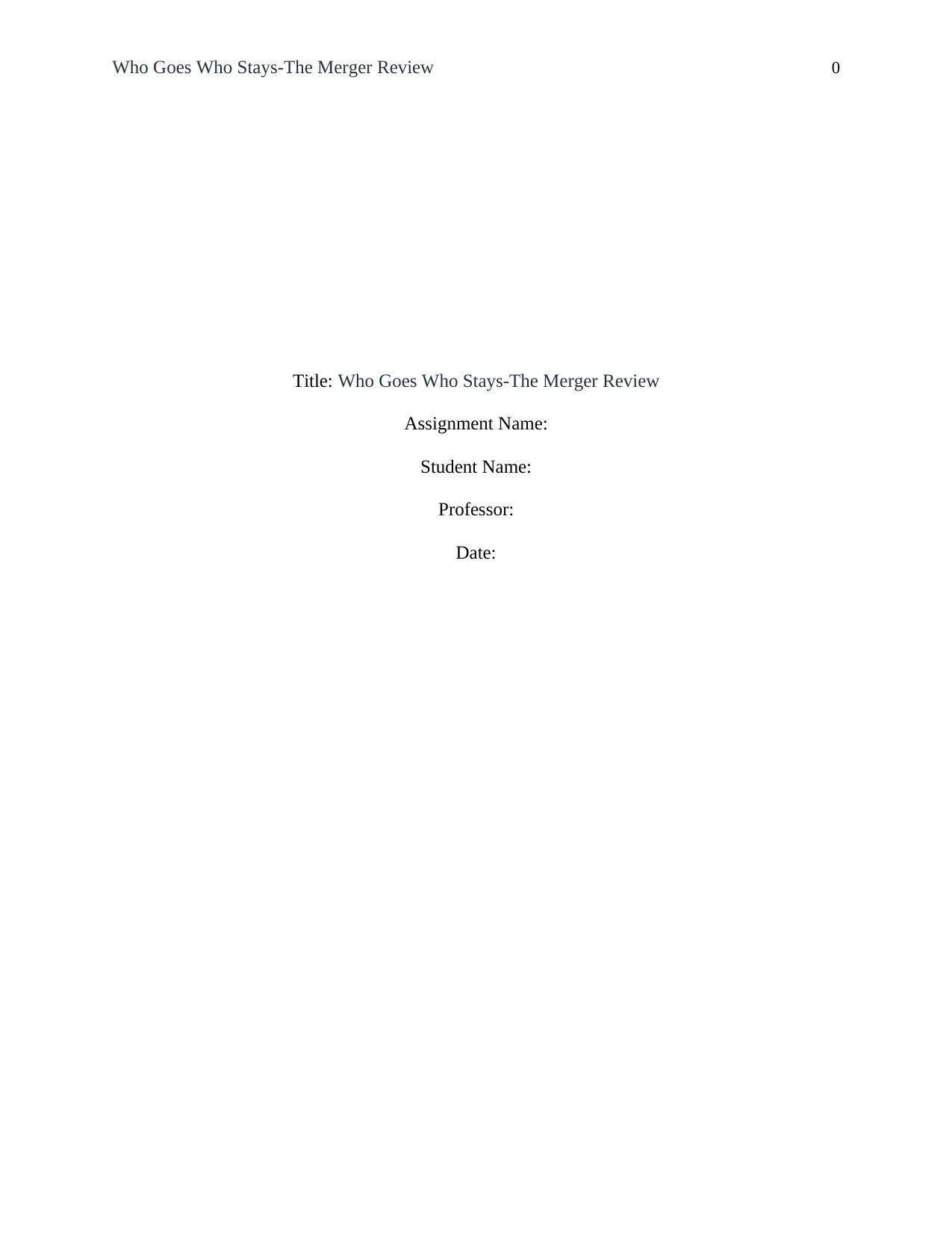
Who Goes Who Stays-The Merger Review 0
Title: Who Goes Who Stays-The Merger Review
Assignment Name:
Student Name:
Professor:
Date:
Title: Who Goes Who Stays-The Merger Review
Assignment Name:
Student Name:
Professor:
Date:
Paraphrase This Document
Need a fresh take? Get an instant paraphrase of this document with our AI Paraphraser
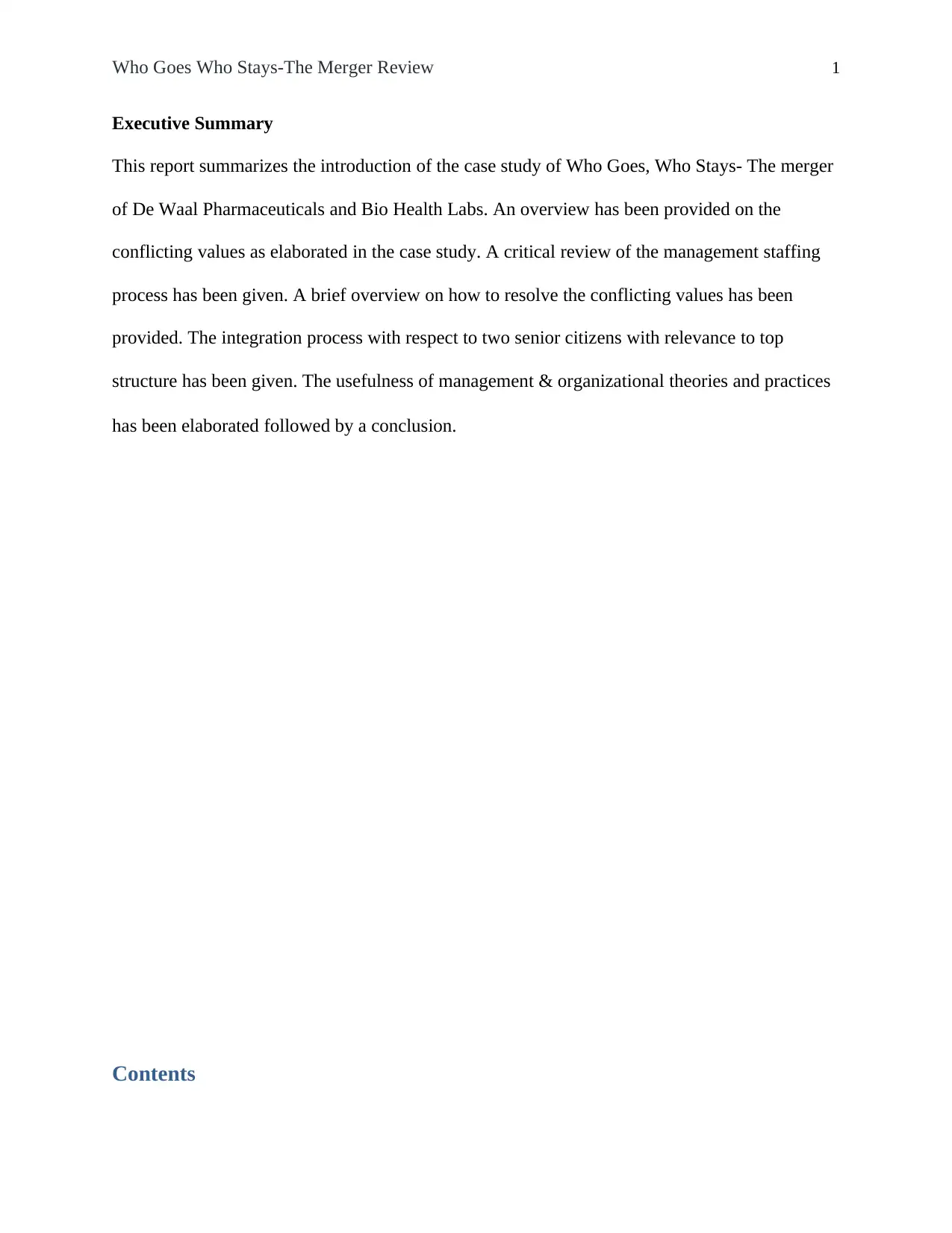
Who Goes Who Stays-The Merger Review 1
Executive Summary
This report summarizes the introduction of the case study of Who Goes, Who Stays- The merger
of De Waal Pharmaceuticals and Bio Health Labs. An overview has been provided on the
conflicting values as elaborated in the case study. A critical review of the management staffing
process has been given. A brief overview on how to resolve the conflicting values has been
provided. The integration process with respect to two senior citizens with relevance to top
structure has been given. The usefulness of management & organizational theories and practices
has been elaborated followed by a conclusion.
Contents
Executive Summary
This report summarizes the introduction of the case study of Who Goes, Who Stays- The merger
of De Waal Pharmaceuticals and Bio Health Labs. An overview has been provided on the
conflicting values as elaborated in the case study. A critical review of the management staffing
process has been given. A brief overview on how to resolve the conflicting values has been
provided. The integration process with respect to two senior citizens with relevance to top
structure has been given. The usefulness of management & organizational theories and practices
has been elaborated followed by a conclusion.
Contents
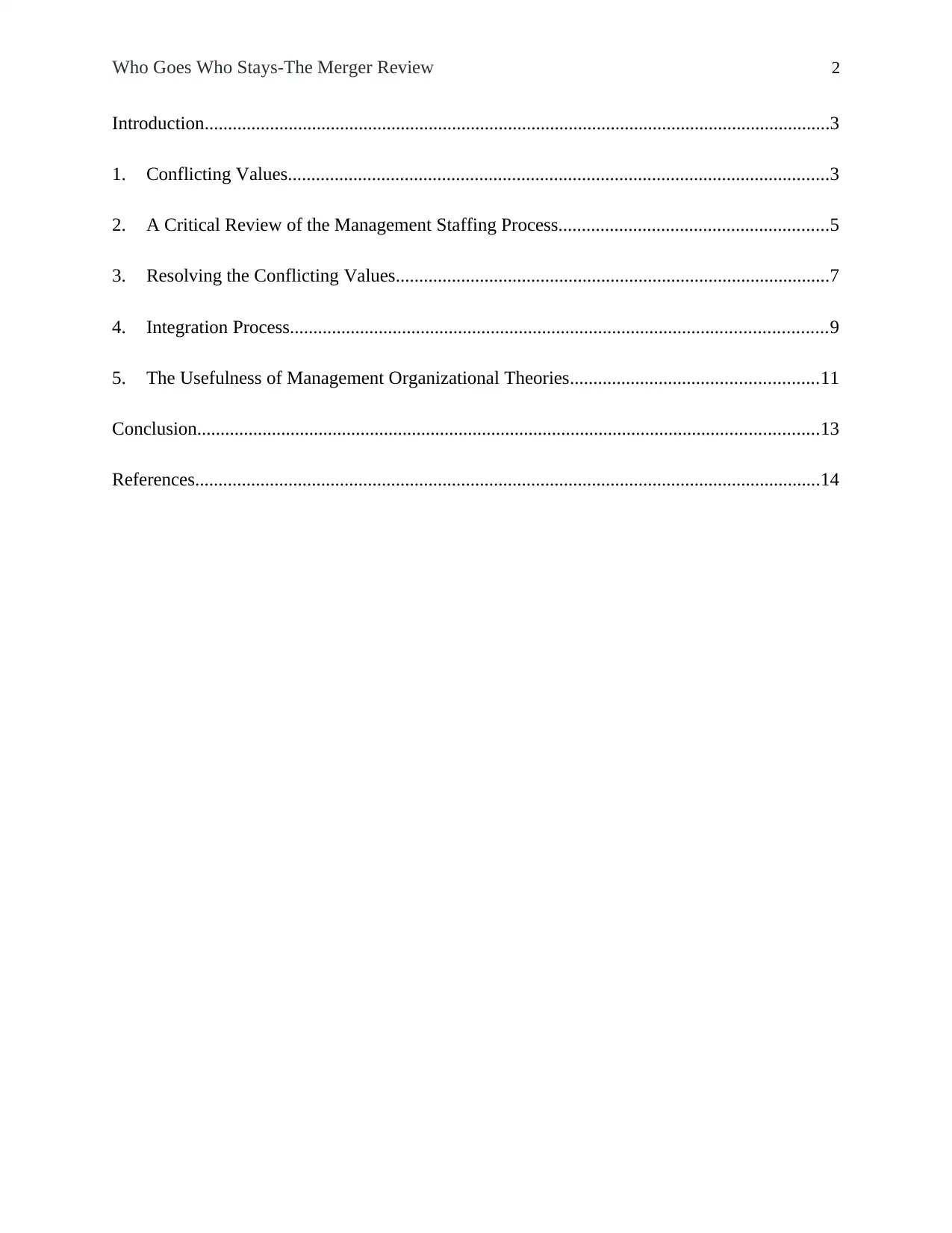
Who Goes Who Stays-The Merger Review 2
Introduction......................................................................................................................................3
1. Conflicting Values....................................................................................................................3
2. A Critical Review of the Management Staffing Process..........................................................5
3. Resolving the Conflicting Values.............................................................................................7
4. Integration Process...................................................................................................................9
5. The Usefulness of Management Organizational Theories.....................................................11
Conclusion.....................................................................................................................................13
References......................................................................................................................................14
Introduction......................................................................................................................................3
1. Conflicting Values....................................................................................................................3
2. A Critical Review of the Management Staffing Process..........................................................5
3. Resolving the Conflicting Values.............................................................................................7
4. Integration Process...................................................................................................................9
5. The Usefulness of Management Organizational Theories.....................................................11
Conclusion.....................................................................................................................................13
References......................................................................................................................................14
⊘ This is a preview!⊘
Do you want full access?
Subscribe today to unlock all pages.

Trusted by 1+ million students worldwide
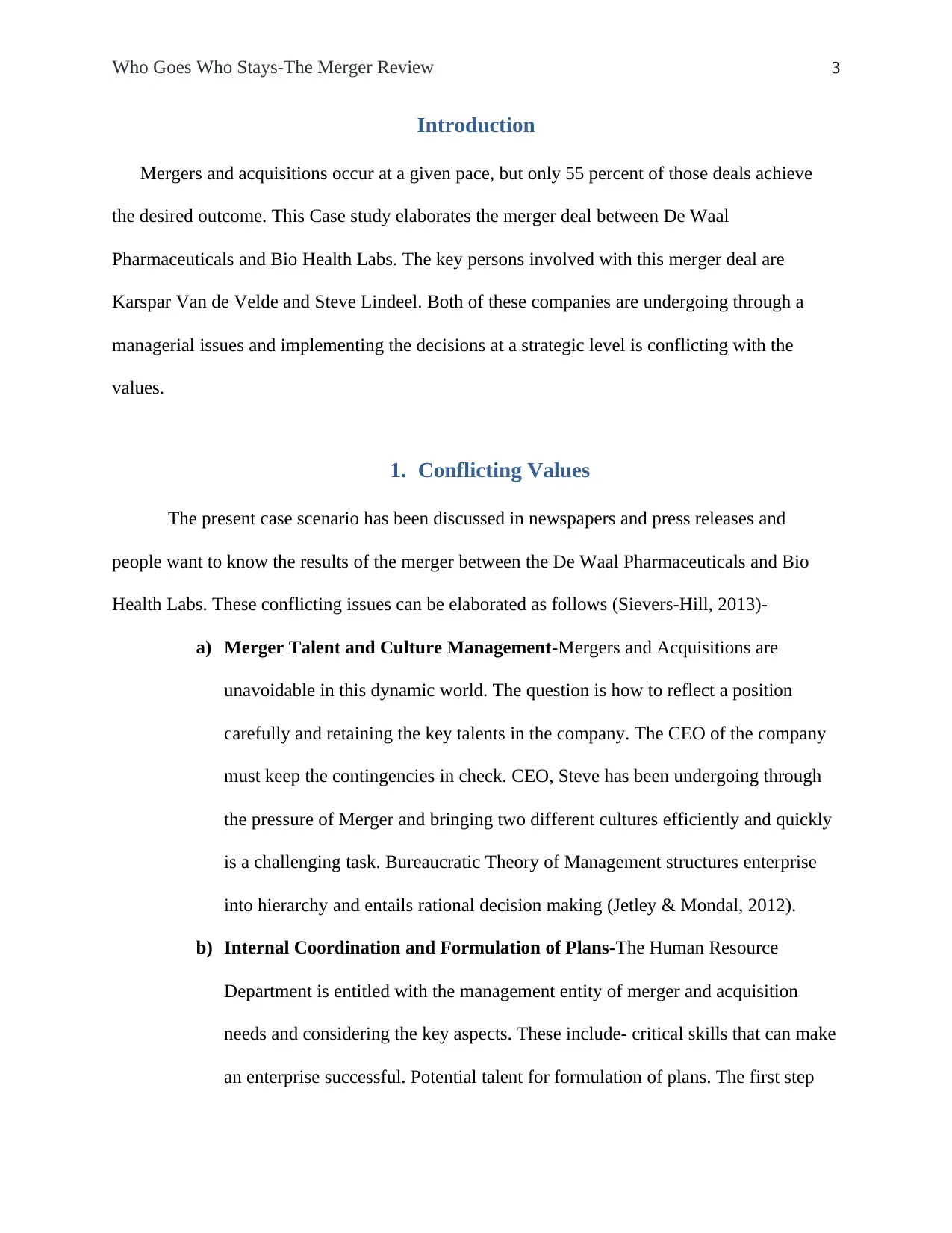
Who Goes Who Stays-The Merger Review 3
Introduction
Mergers and acquisitions occur at a given pace, but only 55 percent of those deals achieve
the desired outcome. This Case study elaborates the merger deal between De Waal
Pharmaceuticals and Bio Health Labs. The key persons involved with this merger deal are
Karspar Van de Velde and Steve Lindeel. Both of these companies are undergoing through a
managerial issues and implementing the decisions at a strategic level is conflicting with the
values.
1. Conflicting Values
The present case scenario has been discussed in newspapers and press releases and
people want to know the results of the merger between the De Waal Pharmaceuticals and Bio
Health Labs. These conflicting issues can be elaborated as follows (Sievers-Hill, 2013)-
a) Merger Talent and Culture Management-Mergers and Acquisitions are
unavoidable in this dynamic world. The question is how to reflect a position
carefully and retaining the key talents in the company. The CEO of the company
must keep the contingencies in check. CEO, Steve has been undergoing through
the pressure of Merger and bringing two different cultures efficiently and quickly
is a challenging task. Bureaucratic Theory of Management structures enterprise
into hierarchy and entails rational decision making (Jetley & Mondal, 2012).
b) Internal Coordination and Formulation of Plans-The Human Resource
Department is entitled with the management entity of merger and acquisition
needs and considering the key aspects. These include- critical skills that can make
an enterprise successful. Potential talent for formulation of plans. The first step
Introduction
Mergers and acquisitions occur at a given pace, but only 55 percent of those deals achieve
the desired outcome. This Case study elaborates the merger deal between De Waal
Pharmaceuticals and Bio Health Labs. The key persons involved with this merger deal are
Karspar Van de Velde and Steve Lindeel. Both of these companies are undergoing through a
managerial issues and implementing the decisions at a strategic level is conflicting with the
values.
1. Conflicting Values
The present case scenario has been discussed in newspapers and press releases and
people want to know the results of the merger between the De Waal Pharmaceuticals and Bio
Health Labs. These conflicting issues can be elaborated as follows (Sievers-Hill, 2013)-
a) Merger Talent and Culture Management-Mergers and Acquisitions are
unavoidable in this dynamic world. The question is how to reflect a position
carefully and retaining the key talents in the company. The CEO of the company
must keep the contingencies in check. CEO, Steve has been undergoing through
the pressure of Merger and bringing two different cultures efficiently and quickly
is a challenging task. Bureaucratic Theory of Management structures enterprise
into hierarchy and entails rational decision making (Jetley & Mondal, 2012).
b) Internal Coordination and Formulation of Plans-The Human Resource
Department is entitled with the management entity of merger and acquisition
needs and considering the key aspects. These include- critical skills that can make
an enterprise successful. Potential talent for formulation of plans. The first step
Paraphrase This Document
Need a fresh take? Get an instant paraphrase of this document with our AI Paraphraser
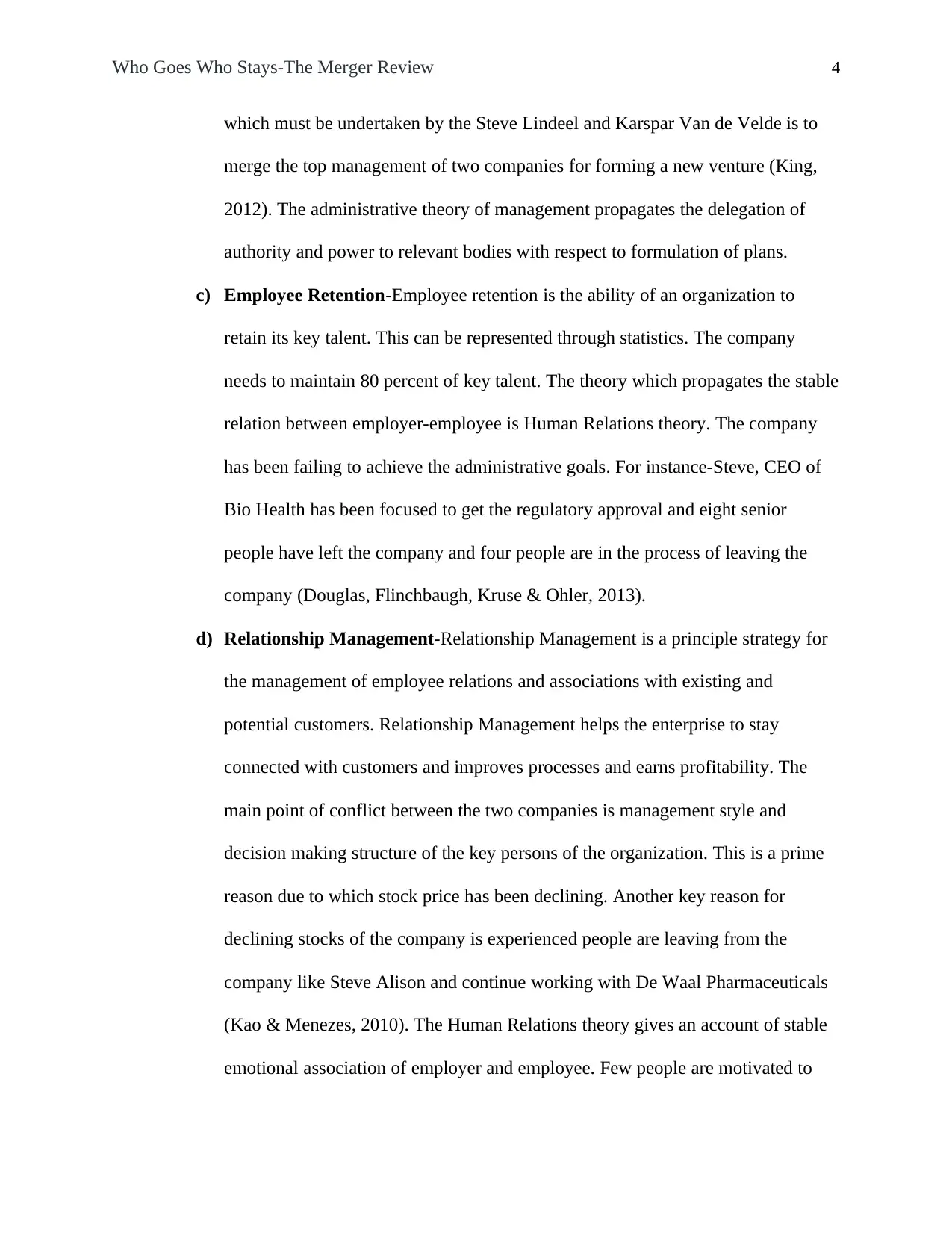
Who Goes Who Stays-The Merger Review 4
which must be undertaken by the Steve Lindeel and Karspar Van de Velde is to
merge the top management of two companies for forming a new venture (King,
2012). The administrative theory of management propagates the delegation of
authority and power to relevant bodies with respect to formulation of plans.
c) Employee Retention-Employee retention is the ability of an organization to
retain its key talent. This can be represented through statistics. The company
needs to maintain 80 percent of key talent. The theory which propagates the stable
relation between employer-employee is Human Relations theory. The company
has been failing to achieve the administrative goals. For instance-Steve, CEO of
Bio Health has been focused to get the regulatory approval and eight senior
people have left the company and four people are in the process of leaving the
company (Douglas, Flinchbaugh, Kruse & Ohler, 2013).
d) Relationship Management-Relationship Management is a principle strategy for
the management of employee relations and associations with existing and
potential customers. Relationship Management helps the enterprise to stay
connected with customers and improves processes and earns profitability. The
main point of conflict between the two companies is management style and
decision making structure of the key persons of the organization. This is a prime
reason due to which stock price has been declining. Another key reason for
declining stocks of the company is experienced people are leaving from the
company like Steve Alison and continue working with De Waal Pharmaceuticals
(Kao & Menezes, 2010). The Human Relations theory gives an account of stable
emotional association of employer and employee. Few people are motivated to
which must be undertaken by the Steve Lindeel and Karspar Van de Velde is to
merge the top management of two companies for forming a new venture (King,
2012). The administrative theory of management propagates the delegation of
authority and power to relevant bodies with respect to formulation of plans.
c) Employee Retention-Employee retention is the ability of an organization to
retain its key talent. This can be represented through statistics. The company
needs to maintain 80 percent of key talent. The theory which propagates the stable
relation between employer-employee is Human Relations theory. The company
has been failing to achieve the administrative goals. For instance-Steve, CEO of
Bio Health has been focused to get the regulatory approval and eight senior
people have left the company and four people are in the process of leaving the
company (Douglas, Flinchbaugh, Kruse & Ohler, 2013).
d) Relationship Management-Relationship Management is a principle strategy for
the management of employee relations and associations with existing and
potential customers. Relationship Management helps the enterprise to stay
connected with customers and improves processes and earns profitability. The
main point of conflict between the two companies is management style and
decision making structure of the key persons of the organization. This is a prime
reason due to which stock price has been declining. Another key reason for
declining stocks of the company is experienced people are leaving from the
company like Steve Alison and continue working with De Waal Pharmaceuticals
(Kao & Menezes, 2010). The Human Relations theory gives an account of stable
emotional association of employer and employee. Few people are motivated to
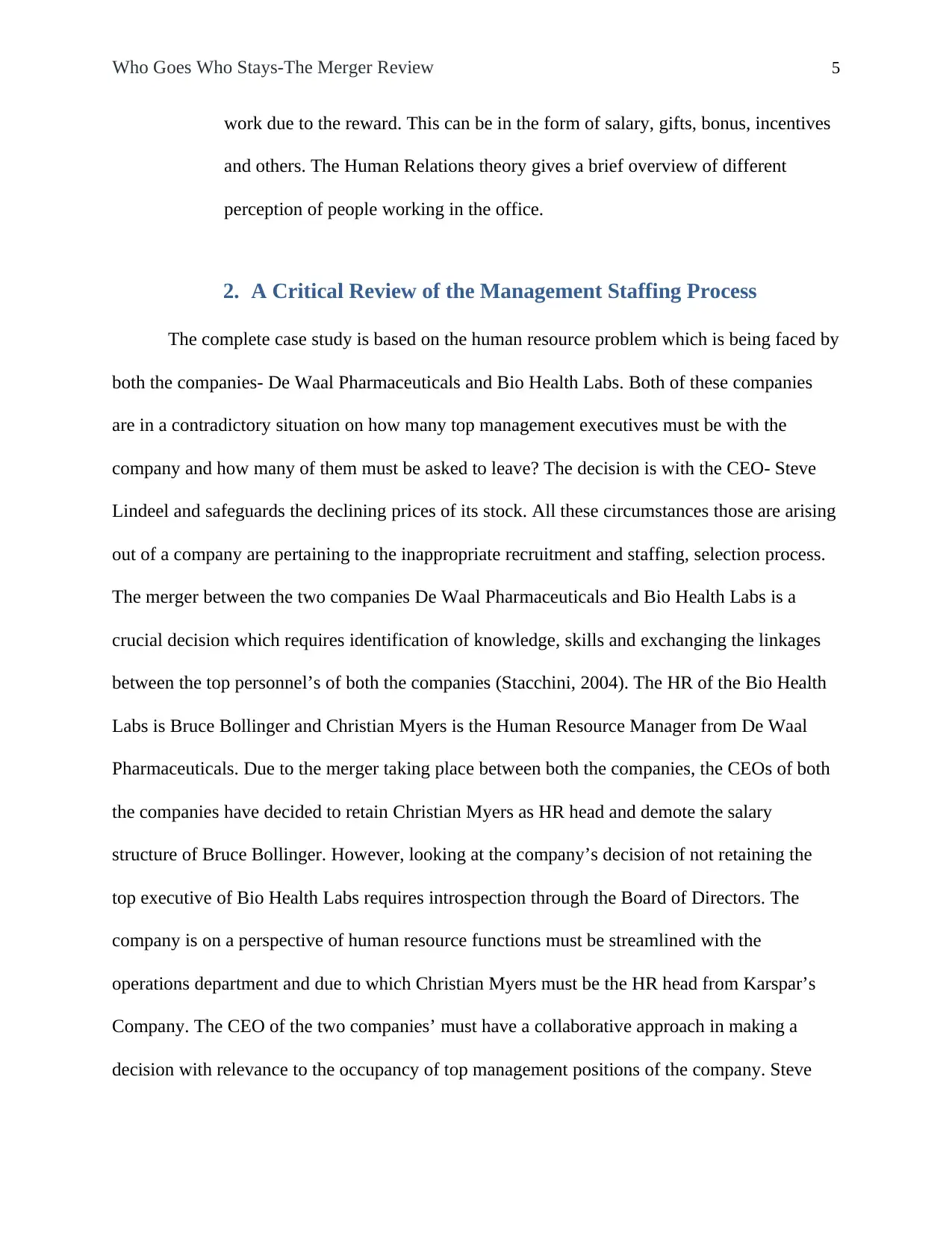
Who Goes Who Stays-The Merger Review 5
work due to the reward. This can be in the form of salary, gifts, bonus, incentives
and others. The Human Relations theory gives a brief overview of different
perception of people working in the office.
2. A Critical Review of the Management Staffing Process
The complete case study is based on the human resource problem which is being faced by
both the companies- De Waal Pharmaceuticals and Bio Health Labs. Both of these companies
are in a contradictory situation on how many top management executives must be with the
company and how many of them must be asked to leave? The decision is with the CEO- Steve
Lindeel and safeguards the declining prices of its stock. All these circumstances those are arising
out of a company are pertaining to the inappropriate recruitment and staffing, selection process.
The merger between the two companies De Waal Pharmaceuticals and Bio Health Labs is a
crucial decision which requires identification of knowledge, skills and exchanging the linkages
between the top personnel’s of both the companies (Stacchini, 2004). The HR of the Bio Health
Labs is Bruce Bollinger and Christian Myers is the Human Resource Manager from De Waal
Pharmaceuticals. Due to the merger taking place between both the companies, the CEOs of both
the companies have decided to retain Christian Myers as HR head and demote the salary
structure of Bruce Bollinger. However, looking at the company’s decision of not retaining the
top executive of Bio Health Labs requires introspection through the Board of Directors. The
company is on a perspective of human resource functions must be streamlined with the
operations department and due to which Christian Myers must be the HR head from Karspar’s
Company. The CEO of the two companies’ must have a collaborative approach in making a
decision with relevance to the occupancy of top management positions of the company. Steve
work due to the reward. This can be in the form of salary, gifts, bonus, incentives
and others. The Human Relations theory gives a brief overview of different
perception of people working in the office.
2. A Critical Review of the Management Staffing Process
The complete case study is based on the human resource problem which is being faced by
both the companies- De Waal Pharmaceuticals and Bio Health Labs. Both of these companies
are in a contradictory situation on how many top management executives must be with the
company and how many of them must be asked to leave? The decision is with the CEO- Steve
Lindeel and safeguards the declining prices of its stock. All these circumstances those are arising
out of a company are pertaining to the inappropriate recruitment and staffing, selection process.
The merger between the two companies De Waal Pharmaceuticals and Bio Health Labs is a
crucial decision which requires identification of knowledge, skills and exchanging the linkages
between the top personnel’s of both the companies (Stacchini, 2004). The HR of the Bio Health
Labs is Bruce Bollinger and Christian Myers is the Human Resource Manager from De Waal
Pharmaceuticals. Due to the merger taking place between both the companies, the CEOs of both
the companies have decided to retain Christian Myers as HR head and demote the salary
structure of Bruce Bollinger. However, looking at the company’s decision of not retaining the
top executive of Bio Health Labs requires introspection through the Board of Directors. The
company is on a perspective of human resource functions must be streamlined with the
operations department and due to which Christian Myers must be the HR head from Karspar’s
Company. The CEO of the two companies’ must have a collaborative approach in making a
decision with relevance to the occupancy of top management positions of the company. Steve
⊘ This is a preview!⊘
Do you want full access?
Subscribe today to unlock all pages.

Trusted by 1+ million students worldwide
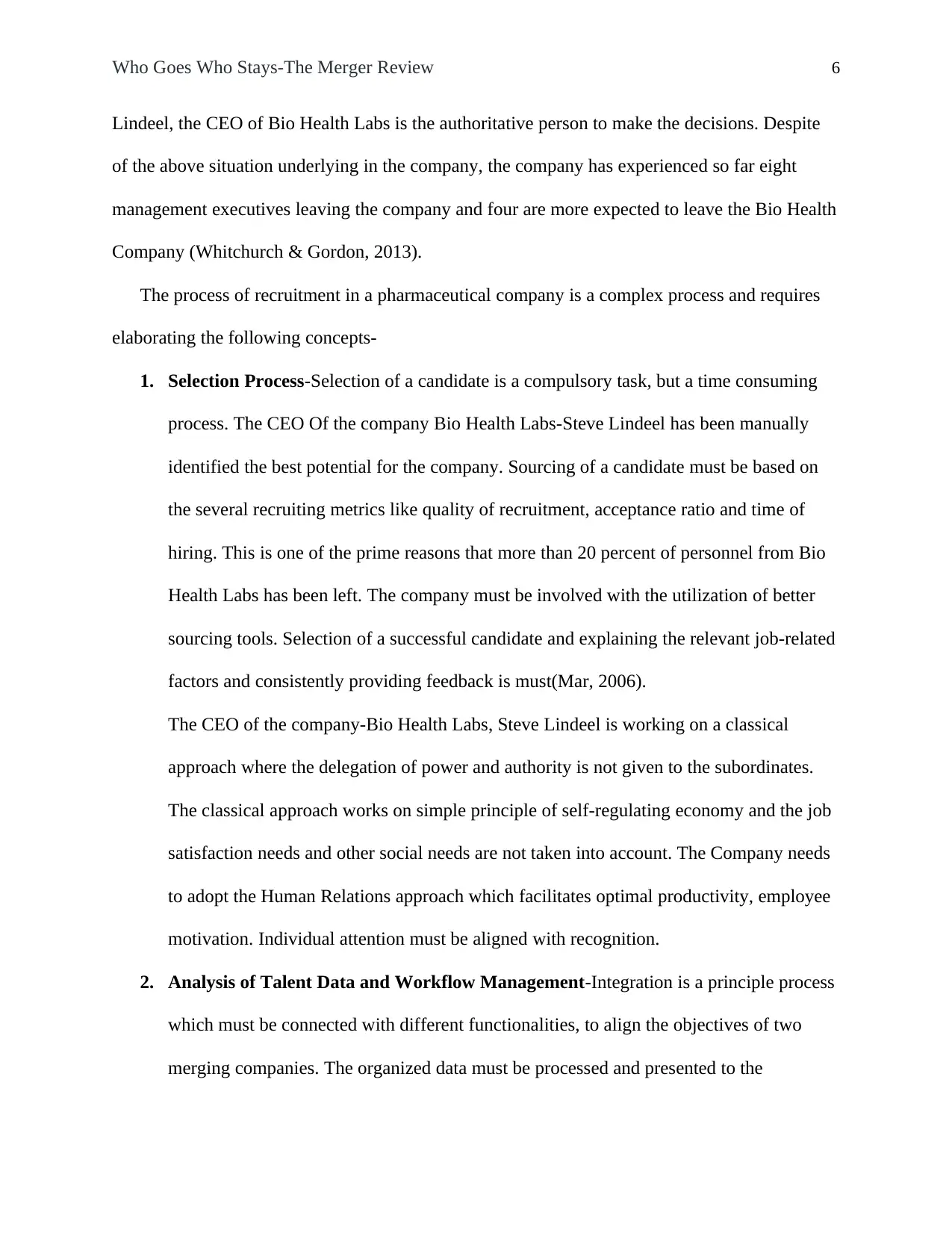
Who Goes Who Stays-The Merger Review 6
Lindeel, the CEO of Bio Health Labs is the authoritative person to make the decisions. Despite
of the above situation underlying in the company, the company has experienced so far eight
management executives leaving the company and four are more expected to leave the Bio Health
Company (Whitchurch & Gordon, 2013).
The process of recruitment in a pharmaceutical company is a complex process and requires
elaborating the following concepts-
1. Selection Process-Selection of a candidate is a compulsory task, but a time consuming
process. The CEO Of the company Bio Health Labs-Steve Lindeel has been manually
identified the best potential for the company. Sourcing of a candidate must be based on
the several recruiting metrics like quality of recruitment, acceptance ratio and time of
hiring. This is one of the prime reasons that more than 20 percent of personnel from Bio
Health Labs has been left. The company must be involved with the utilization of better
sourcing tools. Selection of a successful candidate and explaining the relevant job-related
factors and consistently providing feedback is must(Mar, 2006).
The CEO of the company-Bio Health Labs, Steve Lindeel is working on a classical
approach where the delegation of power and authority is not given to the subordinates.
The classical approach works on simple principle of self-regulating economy and the job
satisfaction needs and other social needs are not taken into account. The Company needs
to adopt the Human Relations approach which facilitates optimal productivity, employee
motivation. Individual attention must be aligned with recognition.
2. Analysis of Talent Data and Workflow Management-Integration is a principle process
which must be connected with different functionalities, to align the objectives of two
merging companies. The organized data must be processed and presented to the
Lindeel, the CEO of Bio Health Labs is the authoritative person to make the decisions. Despite
of the above situation underlying in the company, the company has experienced so far eight
management executives leaving the company and four are more expected to leave the Bio Health
Company (Whitchurch & Gordon, 2013).
The process of recruitment in a pharmaceutical company is a complex process and requires
elaborating the following concepts-
1. Selection Process-Selection of a candidate is a compulsory task, but a time consuming
process. The CEO Of the company Bio Health Labs-Steve Lindeel has been manually
identified the best potential for the company. Sourcing of a candidate must be based on
the several recruiting metrics like quality of recruitment, acceptance ratio and time of
hiring. This is one of the prime reasons that more than 20 percent of personnel from Bio
Health Labs has been left. The company must be involved with the utilization of better
sourcing tools. Selection of a successful candidate and explaining the relevant job-related
factors and consistently providing feedback is must(Mar, 2006).
The CEO of the company-Bio Health Labs, Steve Lindeel is working on a classical
approach where the delegation of power and authority is not given to the subordinates.
The classical approach works on simple principle of self-regulating economy and the job
satisfaction needs and other social needs are not taken into account. The Company needs
to adopt the Human Relations approach which facilitates optimal productivity, employee
motivation. Individual attention must be aligned with recognition.
2. Analysis of Talent Data and Workflow Management-Integration is a principle process
which must be connected with different functionalities, to align the objectives of two
merging companies. The organized data must be processed and presented to the
Paraphrase This Document
Need a fresh take? Get an instant paraphrase of this document with our AI Paraphraser
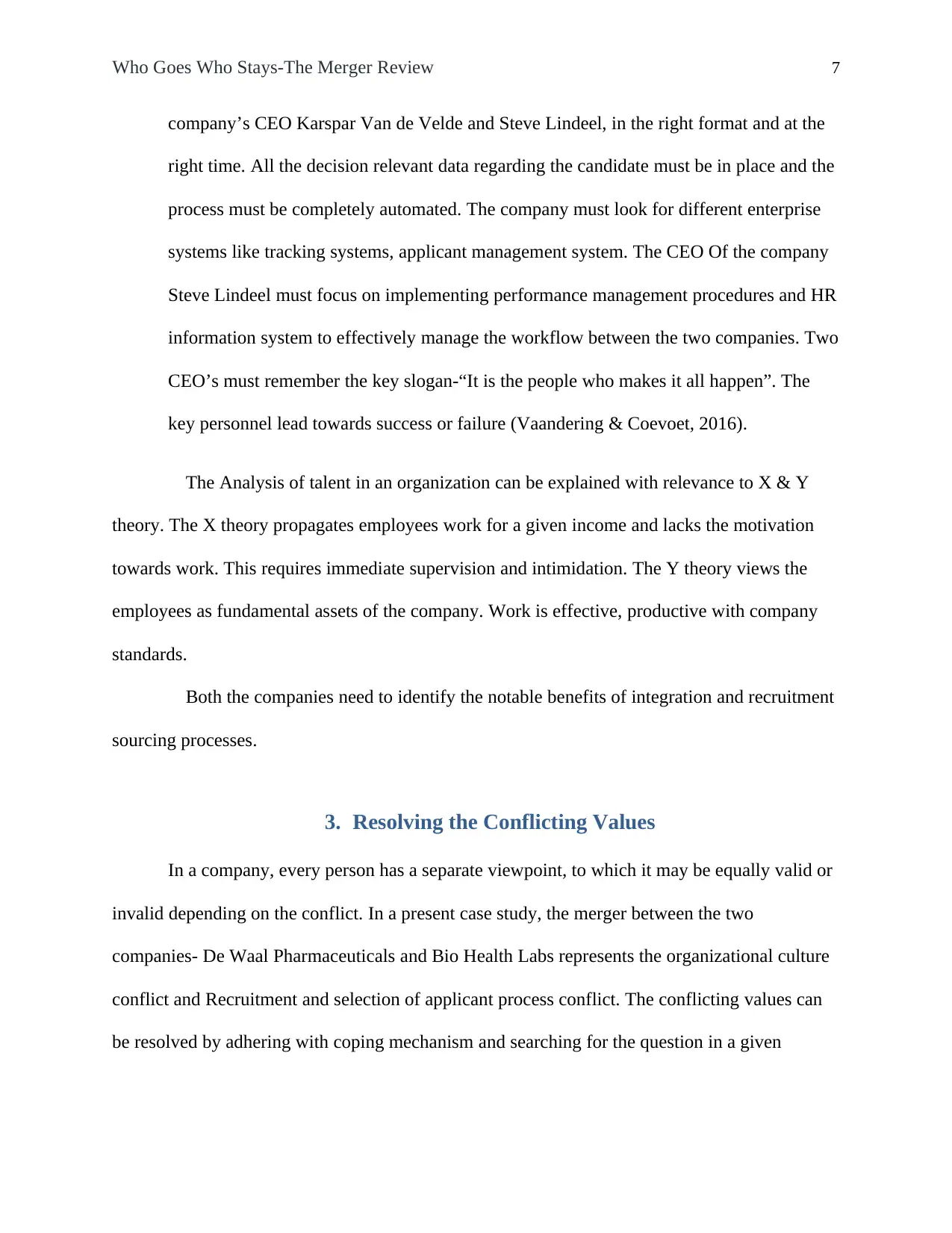
Who Goes Who Stays-The Merger Review 7
company’s CEO Karspar Van de Velde and Steve Lindeel, in the right format and at the
right time. All the decision relevant data regarding the candidate must be in place and the
process must be completely automated. The company must look for different enterprise
systems like tracking systems, applicant management system. The CEO Of the company
Steve Lindeel must focus on implementing performance management procedures and HR
information system to effectively manage the workflow between the two companies. Two
CEO’s must remember the key slogan-“It is the people who makes it all happen”. The
key personnel lead towards success or failure (Vaandering & Coevoet, 2016).
The Analysis of talent in an organization can be explained with relevance to X & Y
theory. The X theory propagates employees work for a given income and lacks the motivation
towards work. This requires immediate supervision and intimidation. The Y theory views the
employees as fundamental assets of the company. Work is effective, productive with company
standards.
Both the companies need to identify the notable benefits of integration and recruitment
sourcing processes.
3. Resolving the Conflicting Values
In a company, every person has a separate viewpoint, to which it may be equally valid or
invalid depending on the conflict. In a present case study, the merger between the two
companies- De Waal Pharmaceuticals and Bio Health Labs represents the organizational culture
conflict and Recruitment and selection of applicant process conflict. The conflicting values can
be resolved by adhering with coping mechanism and searching for the question in a given
company’s CEO Karspar Van de Velde and Steve Lindeel, in the right format and at the
right time. All the decision relevant data regarding the candidate must be in place and the
process must be completely automated. The company must look for different enterprise
systems like tracking systems, applicant management system. The CEO Of the company
Steve Lindeel must focus on implementing performance management procedures and HR
information system to effectively manage the workflow between the two companies. Two
CEO’s must remember the key slogan-“It is the people who makes it all happen”. The
key personnel lead towards success or failure (Vaandering & Coevoet, 2016).
The Analysis of talent in an organization can be explained with relevance to X & Y
theory. The X theory propagates employees work for a given income and lacks the motivation
towards work. This requires immediate supervision and intimidation. The Y theory views the
employees as fundamental assets of the company. Work is effective, productive with company
standards.
Both the companies need to identify the notable benefits of integration and recruitment
sourcing processes.
3. Resolving the Conflicting Values
In a company, every person has a separate viewpoint, to which it may be equally valid or
invalid depending on the conflict. In a present case study, the merger between the two
companies- De Waal Pharmaceuticals and Bio Health Labs represents the organizational culture
conflict and Recruitment and selection of applicant process conflict. The conflicting values can
be resolved by adhering with coping mechanism and searching for the question in a given
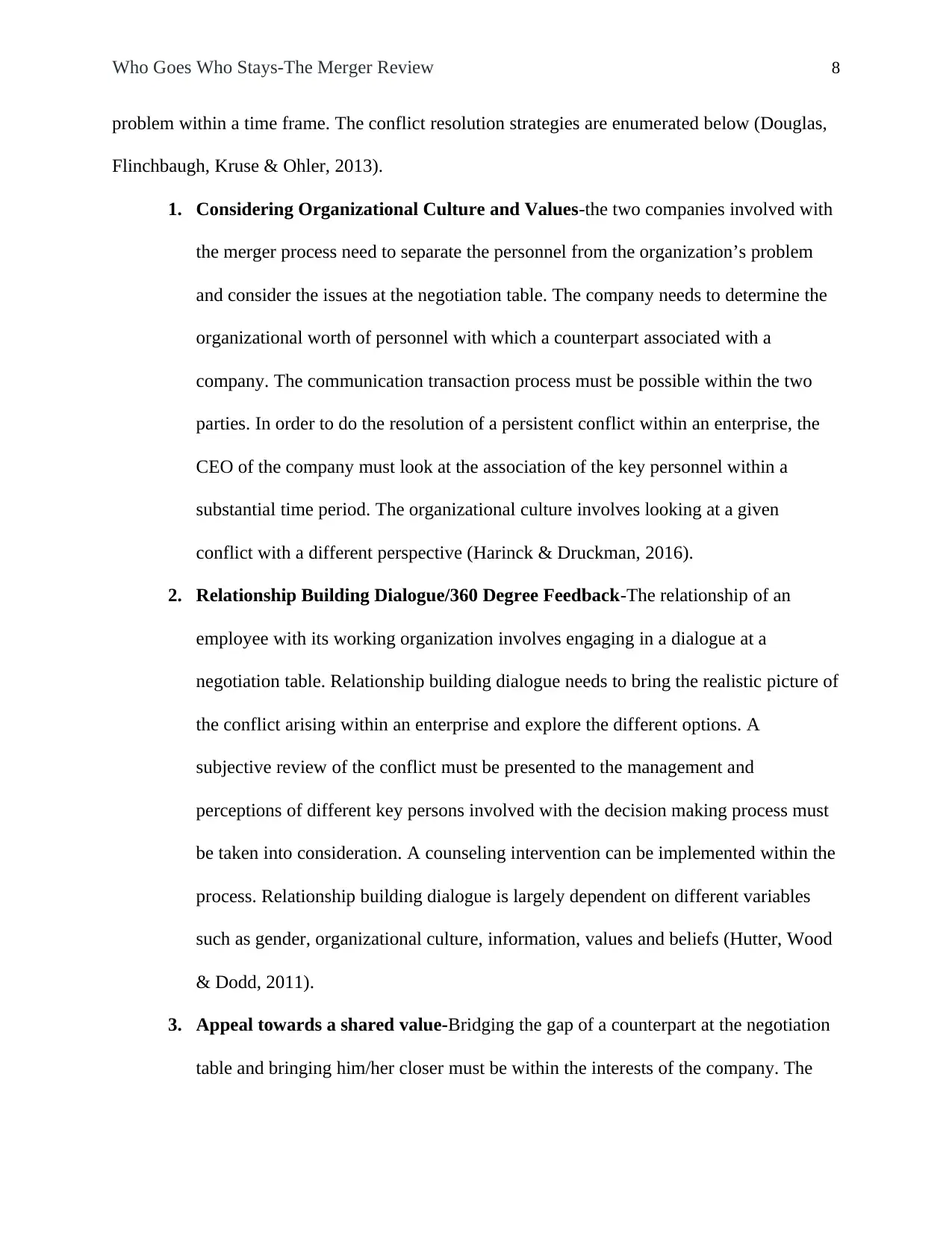
Who Goes Who Stays-The Merger Review 8
problem within a time frame. The conflict resolution strategies are enumerated below (Douglas,
Flinchbaugh, Kruse & Ohler, 2013).
1. Considering Organizational Culture and Values-the two companies involved with
the merger process need to separate the personnel from the organization’s problem
and consider the issues at the negotiation table. The company needs to determine the
organizational worth of personnel with which a counterpart associated with a
company. The communication transaction process must be possible within the two
parties. In order to do the resolution of a persistent conflict within an enterprise, the
CEO of the company must look at the association of the key personnel within a
substantial time period. The organizational culture involves looking at a given
conflict with a different perspective (Harinck & Druckman, 2016).
2. Relationship Building Dialogue/360 Degree Feedback-The relationship of an
employee with its working organization involves engaging in a dialogue at a
negotiation table. Relationship building dialogue needs to bring the realistic picture of
the conflict arising within an enterprise and explore the different options. A
subjective review of the conflict must be presented to the management and
perceptions of different key persons involved with the decision making process must
be taken into consideration. A counseling intervention can be implemented within the
process. Relationship building dialogue is largely dependent on different variables
such as gender, organizational culture, information, values and beliefs (Hutter, Wood
& Dodd, 2011).
3. Appeal towards a shared value-Bridging the gap of a counterpart at the negotiation
table and bringing him/her closer must be within the interests of the company. The
problem within a time frame. The conflict resolution strategies are enumerated below (Douglas,
Flinchbaugh, Kruse & Ohler, 2013).
1. Considering Organizational Culture and Values-the two companies involved with
the merger process need to separate the personnel from the organization’s problem
and consider the issues at the negotiation table. The company needs to determine the
organizational worth of personnel with which a counterpart associated with a
company. The communication transaction process must be possible within the two
parties. In order to do the resolution of a persistent conflict within an enterprise, the
CEO of the company must look at the association of the key personnel within a
substantial time period. The organizational culture involves looking at a given
conflict with a different perspective (Harinck & Druckman, 2016).
2. Relationship Building Dialogue/360 Degree Feedback-The relationship of an
employee with its working organization involves engaging in a dialogue at a
negotiation table. Relationship building dialogue needs to bring the realistic picture of
the conflict arising within an enterprise and explore the different options. A
subjective review of the conflict must be presented to the management and
perceptions of different key persons involved with the decision making process must
be taken into consideration. A counseling intervention can be implemented within the
process. Relationship building dialogue is largely dependent on different variables
such as gender, organizational culture, information, values and beliefs (Hutter, Wood
& Dodd, 2011).
3. Appeal towards a shared value-Bridging the gap of a counterpart at the negotiation
table and bringing him/her closer must be within the interests of the company. The
⊘ This is a preview!⊘
Do you want full access?
Subscribe today to unlock all pages.

Trusted by 1+ million students worldwide
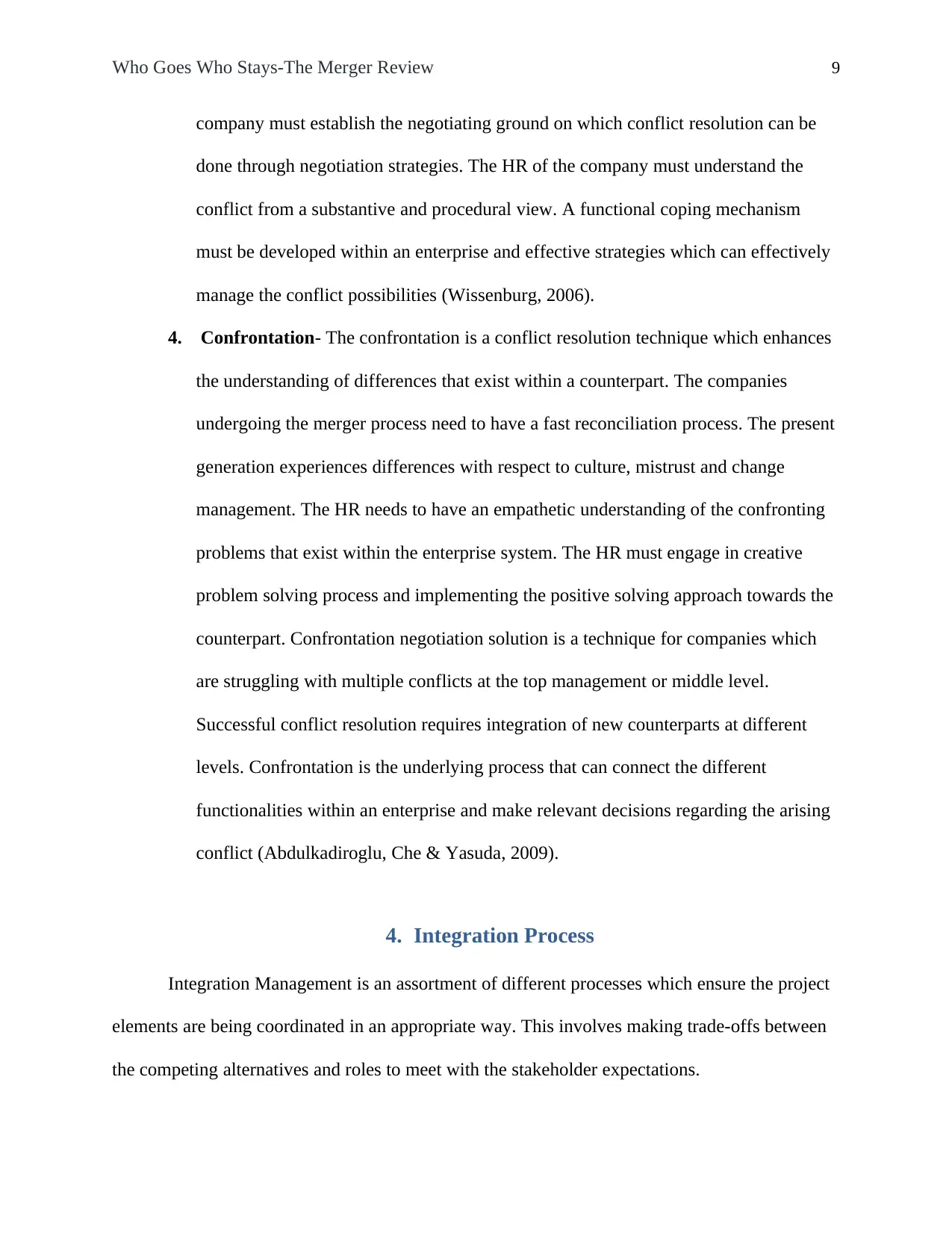
Who Goes Who Stays-The Merger Review 9
company must establish the negotiating ground on which conflict resolution can be
done through negotiation strategies. The HR of the company must understand the
conflict from a substantive and procedural view. A functional coping mechanism
must be developed within an enterprise and effective strategies which can effectively
manage the conflict possibilities (Wissenburg, 2006).
4. Confrontation- The confrontation is a conflict resolution technique which enhances
the understanding of differences that exist within a counterpart. The companies
undergoing the merger process need to have a fast reconciliation process. The present
generation experiences differences with respect to culture, mistrust and change
management. The HR needs to have an empathetic understanding of the confronting
problems that exist within the enterprise system. The HR must engage in creative
problem solving process and implementing the positive solving approach towards the
counterpart. Confrontation negotiation solution is a technique for companies which
are struggling with multiple conflicts at the top management or middle level.
Successful conflict resolution requires integration of new counterparts at different
levels. Confrontation is the underlying process that can connect the different
functionalities within an enterprise and make relevant decisions regarding the arising
conflict (Abdulkadiroglu, Che & Yasuda, 2009).
4. Integration Process
Integration Management is an assortment of different processes which ensure the project
elements are being coordinated in an appropriate way. This involves making trade-offs between
the competing alternatives and roles to meet with the stakeholder expectations.
company must establish the negotiating ground on which conflict resolution can be
done through negotiation strategies. The HR of the company must understand the
conflict from a substantive and procedural view. A functional coping mechanism
must be developed within an enterprise and effective strategies which can effectively
manage the conflict possibilities (Wissenburg, 2006).
4. Confrontation- The confrontation is a conflict resolution technique which enhances
the understanding of differences that exist within a counterpart. The companies
undergoing the merger process need to have a fast reconciliation process. The present
generation experiences differences with respect to culture, mistrust and change
management. The HR needs to have an empathetic understanding of the confronting
problems that exist within the enterprise system. The HR must engage in creative
problem solving process and implementing the positive solving approach towards the
counterpart. Confrontation negotiation solution is a technique for companies which
are struggling with multiple conflicts at the top management or middle level.
Successful conflict resolution requires integration of new counterparts at different
levels. Confrontation is the underlying process that can connect the different
functionalities within an enterprise and make relevant decisions regarding the arising
conflict (Abdulkadiroglu, Che & Yasuda, 2009).
4. Integration Process
Integration Management is an assortment of different processes which ensure the project
elements are being coordinated in an appropriate way. This involves making trade-offs between
the competing alternatives and roles to meet with the stakeholder expectations.
Paraphrase This Document
Need a fresh take? Get an instant paraphrase of this document with our AI Paraphraser
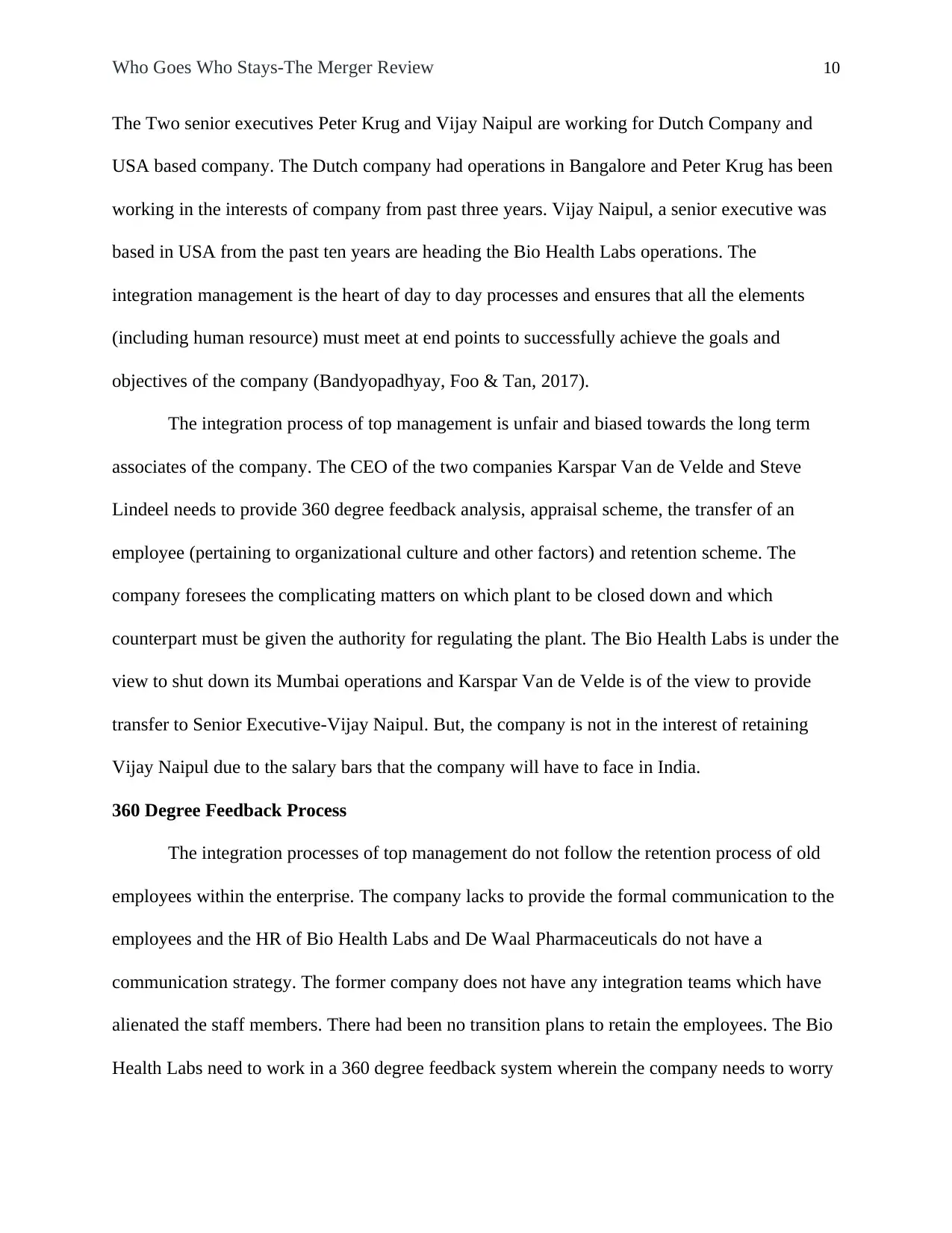
Who Goes Who Stays-The Merger Review 10
The Two senior executives Peter Krug and Vijay Naipul are working for Dutch Company and
USA based company. The Dutch company had operations in Bangalore and Peter Krug has been
working in the interests of company from past three years. Vijay Naipul, a senior executive was
based in USA from the past ten years are heading the Bio Health Labs operations. The
integration management is the heart of day to day processes and ensures that all the elements
(including human resource) must meet at end points to successfully achieve the goals and
objectives of the company (Bandyopadhyay, Foo & Tan, 2017).
The integration process of top management is unfair and biased towards the long term
associates of the company. The CEO of the two companies Karspar Van de Velde and Steve
Lindeel needs to provide 360 degree feedback analysis, appraisal scheme, the transfer of an
employee (pertaining to organizational culture and other factors) and retention scheme. The
company foresees the complicating matters on which plant to be closed down and which
counterpart must be given the authority for regulating the plant. The Bio Health Labs is under the
view to shut down its Mumbai operations and Karspar Van de Velde is of the view to provide
transfer to Senior Executive-Vijay Naipul. But, the company is not in the interest of retaining
Vijay Naipul due to the salary bars that the company will have to face in India.
360 Degree Feedback Process
The integration processes of top management do not follow the retention process of old
employees within the enterprise. The company lacks to provide the formal communication to the
employees and the HR of Bio Health Labs and De Waal Pharmaceuticals do not have a
communication strategy. The former company does not have any integration teams which have
alienated the staff members. There had been no transition plans to retain the employees. The Bio
Health Labs need to work in a 360 degree feedback system wherein the company needs to worry
The Two senior executives Peter Krug and Vijay Naipul are working for Dutch Company and
USA based company. The Dutch company had operations in Bangalore and Peter Krug has been
working in the interests of company from past three years. Vijay Naipul, a senior executive was
based in USA from the past ten years are heading the Bio Health Labs operations. The
integration management is the heart of day to day processes and ensures that all the elements
(including human resource) must meet at end points to successfully achieve the goals and
objectives of the company (Bandyopadhyay, Foo & Tan, 2017).
The integration process of top management is unfair and biased towards the long term
associates of the company. The CEO of the two companies Karspar Van de Velde and Steve
Lindeel needs to provide 360 degree feedback analysis, appraisal scheme, the transfer of an
employee (pertaining to organizational culture and other factors) and retention scheme. The
company foresees the complicating matters on which plant to be closed down and which
counterpart must be given the authority for regulating the plant. The Bio Health Labs is under the
view to shut down its Mumbai operations and Karspar Van de Velde is of the view to provide
transfer to Senior Executive-Vijay Naipul. But, the company is not in the interest of retaining
Vijay Naipul due to the salary bars that the company will have to face in India.
360 Degree Feedback Process
The integration processes of top management do not follow the retention process of old
employees within the enterprise. The company lacks to provide the formal communication to the
employees and the HR of Bio Health Labs and De Waal Pharmaceuticals do not have a
communication strategy. The former company does not have any integration teams which have
alienated the staff members. There had been no transition plans to retain the employees. The Bio
Health Labs need to work in a 360 degree feedback system wherein the company needs to worry
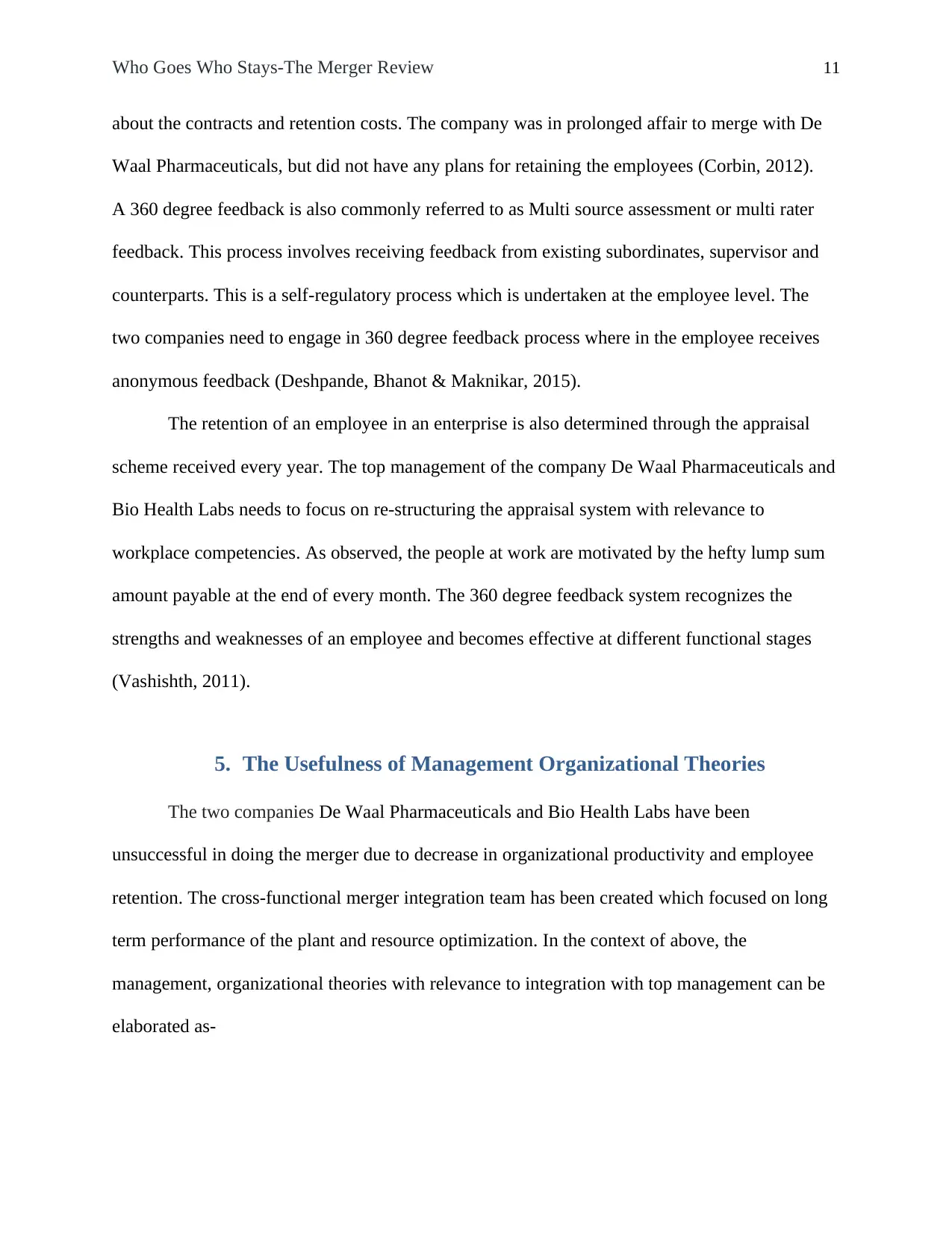
Who Goes Who Stays-The Merger Review 11
about the contracts and retention costs. The company was in prolonged affair to merge with De
Waal Pharmaceuticals, but did not have any plans for retaining the employees (Corbin, 2012).
A 360 degree feedback is also commonly referred to as Multi source assessment or multi rater
feedback. This process involves receiving feedback from existing subordinates, supervisor and
counterparts. This is a self-regulatory process which is undertaken at the employee level. The
two companies need to engage in 360 degree feedback process where in the employee receives
anonymous feedback (Deshpande, Bhanot & Maknikar, 2015).
The retention of an employee in an enterprise is also determined through the appraisal
scheme received every year. The top management of the company De Waal Pharmaceuticals and
Bio Health Labs needs to focus on re-structuring the appraisal system with relevance to
workplace competencies. As observed, the people at work are motivated by the hefty lump sum
amount payable at the end of every month. The 360 degree feedback system recognizes the
strengths and weaknesses of an employee and becomes effective at different functional stages
(Vashishth, 2011).
5. The Usefulness of Management Organizational Theories
The two companies De Waal Pharmaceuticals and Bio Health Labs have been
unsuccessful in doing the merger due to decrease in organizational productivity and employee
retention. The cross-functional merger integration team has been created which focused on long
term performance of the plant and resource optimization. In the context of above, the
management, organizational theories with relevance to integration with top management can be
elaborated as-
about the contracts and retention costs. The company was in prolonged affair to merge with De
Waal Pharmaceuticals, but did not have any plans for retaining the employees (Corbin, 2012).
A 360 degree feedback is also commonly referred to as Multi source assessment or multi rater
feedback. This process involves receiving feedback from existing subordinates, supervisor and
counterparts. This is a self-regulatory process which is undertaken at the employee level. The
two companies need to engage in 360 degree feedback process where in the employee receives
anonymous feedback (Deshpande, Bhanot & Maknikar, 2015).
The retention of an employee in an enterprise is also determined through the appraisal
scheme received every year. The top management of the company De Waal Pharmaceuticals and
Bio Health Labs needs to focus on re-structuring the appraisal system with relevance to
workplace competencies. As observed, the people at work are motivated by the hefty lump sum
amount payable at the end of every month. The 360 degree feedback system recognizes the
strengths and weaknesses of an employee and becomes effective at different functional stages
(Vashishth, 2011).
5. The Usefulness of Management Organizational Theories
The two companies De Waal Pharmaceuticals and Bio Health Labs have been
unsuccessful in doing the merger due to decrease in organizational productivity and employee
retention. The cross-functional merger integration team has been created which focused on long
term performance of the plant and resource optimization. In the context of above, the
management, organizational theories with relevance to integration with top management can be
elaborated as-
⊘ This is a preview!⊘
Do you want full access?
Subscribe today to unlock all pages.

Trusted by 1+ million students worldwide
1 out of 16
Related Documents
Your All-in-One AI-Powered Toolkit for Academic Success.
+13062052269
info@desklib.com
Available 24*7 on WhatsApp / Email
![[object Object]](/_next/static/media/star-bottom.7253800d.svg)
Unlock your academic potential
Copyright © 2020–2025 A2Z Services. All Rights Reserved. Developed and managed by ZUCOL.





